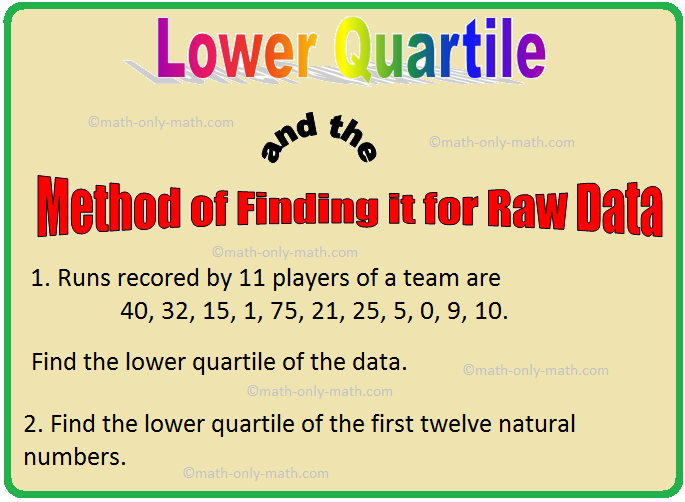Subscribe to our ▶️ YouTube channel 🔴 for the latest videos, updates, and tips.
Lower Quartile and the Method of Finding it for Raw Data
The three variates which divide the data of a distribution in four equal parts (quarters) are called quartiles. As such, the median is the second quartile.
Lower quartile and the method of finding it for raw data
If the data are arranged in ascending or descending order then the variate lying at the middle between the lowest variates and the median is called the lower quartile (or the first quartile), and it is denoted by Q1.
In order to calculate the lower quartile of law data, follow these steps.
Step I: Arrange the data in ascending order. (Do not arrange in descending order.)
Step II: Find the number of variates in the data. Let it be n. Then find the lower quartile as follows.
If n is not divisible by 4 then the mth variate is the lower quartile, where m is the integer just greater then \(\frac{n}{4}\).
If n is divisible by 4 then the lower quartile is the mean of the \(\frac{n}{4}\)th variate and the variate just greater than it.
Solved Problems on Lower Quartile and the Method of Finding it for Raw Data:
1. Runs recored by 11 players of a team are 40, 32, 15, 1, 75, 21, 25, 5, 0, 9, 10.
Find the lower quartile of the data.
Solution:
Arrange the variates in ascending order, we have
0, 1, 5, 9, 10, 15, 21, 25, 32, 40, 75.
Here, n = 11.
So, \(\frac{n}{4}\) = \(\frac{11}{4}\) = 2.75.
As n is not divisible by 4, m will be an integer just greater than \(\frac{n}{4}\),
i.e., m = 3.
Therefore, the third variate is the lower quartile. So, the lower quartile Q1 = 5.
2. Find the lower quartile of the first twelve natural numbers.
Solution:
Here, the variates in ascending order are
1, 2, 3, 4, 5, 6, 7, 8, 9, 10, 11, 12.
Therefore, n = 12.
So, \(\frac{n}{4}\) = \(\frac{12}{4}\) = 3, i.e., n is divisible by 4.
Therefore, the mean of the 3rd varikate (here 3) and the 4th variate (here 4) is Q1.
Therefore, Q1 = \(\frac{3 + 4}{2}\) = 3.5
From Lower Quartile and the Method of Finding it for Raw Data to HOME PAGE
Didn't find what you were looking for? Or want to know more information about Math Only Math. Use this Google Search to find what you need.



New! Comments
Have your say about what you just read! Leave me a comment in the box below. Ask a Question or Answer a Question.